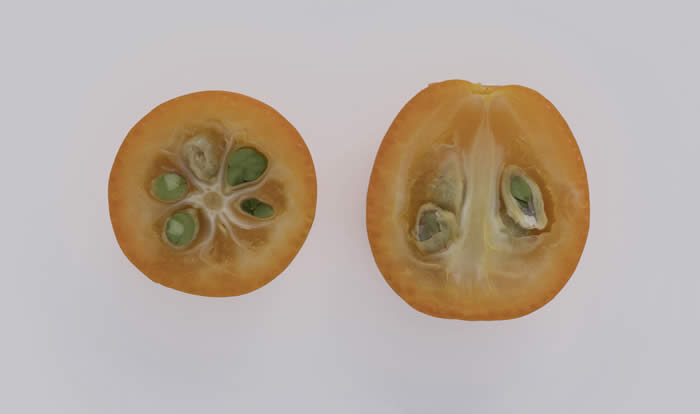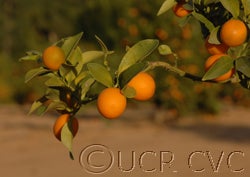Fortunella japonica
CRC 4125
PI 539908
VI 673
Source
Received as budwood from INRA, San Giuliano, Corsica, 2003.
Parentage/origins
Parents unknown.
Rootstocks of accession
Citrus macrophylla
Season of ripeness at Riverside
Year round
Season of flowering at Riverside
May to August
Notes and observations
Budwood obtained from Germplasm Agrumes Collection at Station de Recherches Agronomiques. Source of selection in Corsican collection unknown. The SRA website states that this accession was introduced to Corsica as budwood but no origin is shown.
Description from The Citrus Industry Vol. 1 (1967)
"The first fairly complete description of this species, under the name Citrus japonica, was published in 1784 by Thunberg in his Flora japonica; it reads in translation, as follows: "petiole winged, leaves acute, shrubby stem. Japanese: Kin Kan, vulgo Fime tats banna, Kaempf., Am. ex., Fase. V. p. 801. Growing here and there, often cultivated for its little fruits. Stem shrubby, compressed-subangulate, erect, glabrous, scarcely a foot high. Branches and branchlets alternate, compressed-angular, spinose, glabrous, erect, green. Spines solitary, in the axils of the leaves, erect divergent. Leaves few, with winged petioles, ovate, somewhat acute, entire, somewhat concave, glabrous, dark green above, paler below, erect, spreading, 1 in. [2.5 cm] long, with very minute glands ('poris'). Petioles winged. 1 line [2 mm] long. Flowers axillary, often solitary, rarely paired, pediculate, nodding. Pedicels glabrous, hanging down, 1 line [2 mm] long. Parianth, 1-phyllous, green, glabrous, minute, 5-toothed. Petals 5, white, oblong, somewhat concave, spreading, somewhat claw-like. Filaments 19, subulate, compressed, erect, in 5 more or less coherent bundles, connate, forming a cylinder, shorter than the corolla, nearly equal in length, white. Anthers oblong, small, yellow. Ovary superior, subglobose, glabrous. Style solitary, cylindrical, slightly shorter than the stamens, greenish white. Stigma simple, globose, yellow, striate, many-locular within. Fruit with fleshy peel, vesicular pulp, 9-locular [sic], the size of a cherry. Differs from the other species of Citrus especially in being a very small shrub with minute fruits; thus it can scarcely be considered as a variety of orange. It resembles Citrus medica in the axillary flowers, but differs in the winged petioles; it differs from the orange in the axillary flowers, which are solitary or paired, never in panicles. Fruit ripens in December and January, is very sweet, agreeable and edible."
This description was evidently drawn from a very small plant, perhaps an artificially dwarfed one, such as are commonly grown in Japan. The very small leaves with axillary spines, and the fruits "the size of a cherry" strongly indicate that Thunberg was describing the round kumquat and not the oval kumquat (F. margarita). His plate of this plant published in 1800 shows a flowering twig with small leaves and well-developed axillary spines.
Hume (1903 and 1926) described this species as follows:
"Tree similar to Nagami [F. margarita], except that it is slightly thorny, and has the leaves somewhat smaller and rounder at the apex. Leaves oval; apex obtuse; margin crenate halfway down the length; veins slightly more conspicuous than in Nagami; borne on short rigid, inconspicuously winged petioles, 1/4 to 1/2 in. [6-13 mm] in length. Fruit spherical or somewhat oblate, 1 to 1 1/4 inches [2.5-3 cm] in diameter; golden yellow, short stalked; calyx small; rind smooth, thin, spicy to the taste and aromatic when bruised; oil cells large; pulp sparse; juice acid; sections four to seven; seeds one to three, small, oval, greenish; cotyledons two, greenish. Season same as Nagami."
Availability
Commercially available through the Citrus Clonal Protection Program. Click here to order budwood.
USDA Germplasm Resources Information Network page for Marumi kumquat (CRC 4125)



